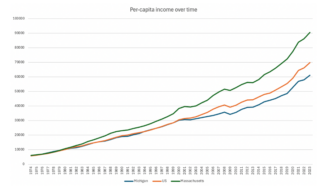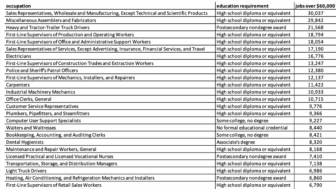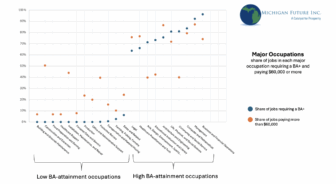Last year, we released a proposal for the Neighborhood Talent Concentration Initiative (NTCI). The proposal was built on what we see as the new calculus of economic development: that talent attracts capital, and quality of place attracts talent. If you want a thriving state economy, you need to create the kinds of places that attract talent at scale.
These places share common characteristics. They are dense, walkable, activity-rich neighborhoods, situated in our nation’s big cities. The goal of the NTCI is to give our central cities the resources they need to create these neighborhoods: dense, walkable, activity-rich neighborhoods, infused greenspace, art and cultural offerings, and vibrant commercial corridors. At present, these kinds of neighborhoods – that concentrate talent, at scale – largely don’t exist in Michigan.
To give you an idea of what we mean, we looked at the density of young talent across every census tract in the U.S. In many cities a census tract is a decent approximation of a neighborhood; in others a few census tracts might fit into commonly conceived neighborhood boundaries. In major cities, tracts can range in size from less than 0.1 square miles in dense cities to around 0.5 square miles in those with more sprawl.
For this exercise we defined “young talent” as those aged 25-34 with a bachelor’s degree or higher. We care about young talent in particular because they are by far the most mobile segment of the population; landing more of these folks sets the foundation for economic prosperity in years to come.
To create a single, comparable metric across census tracts we looked at the number of 25-34 year old’s with a bachelor’s degree or higher (from here out referred to as YTs) per 0.1 square miles. We then ranked every tract in the country by the density of YTs in each tract.
The tracts with the highest density of YTs are exactly those you’d expect – they are the ones your kids moved to after college. There are four tracts on the Upper East Side and Upper West Side of Manhattan with YT densities of over 5,000 per 0.1 square mile. A tract in Chicago’s Near North Side/Gold Coast neighborhood has a density of 4,600 YTs per 0.1 square mile. A tract in the Uptown neighborhood of Seattle has a density of nearly 4,000 YTs per 0.1 square mile.
All told, there are hundreds of tracts with densities of over 1,000 YTs per 0.1 square mile, and the vast majority are in the same kinds of places: Manhattan, Brooklyn, Chicago, Philadelphia, Seattle, San Francisco, Boston, Washington D.C. A bit further down the list you’ll find neighborhoods in LA and Atlanta, where there is a bit more sprawl, but still relatively high YT concentration.
Where do you find our major cities on this list? You have to do some digging. The highest density tract in Detroit encompasses Lafayette Park (featuring some of the highest density housing in the city, with both the Lafayette Park Townhomes and Lafayette Towers) and has a density of just 319 YTs per 0.1 square mile. The highest density tract in Grand Rapids is in the East Hills neighborhood, with a density of just 282 YTs per 0.1 square miles.
One might argue that we shouldn’t compare talent concentrations in our major cities to the “superstar” cities listed above. Though I disagree with this idea (cities can undergo dramatic transformations – Boston, for instance, was a declining industrial town in 1980, before redefining itself as a knowledge economy hub), looking at what might be considered more apt comparisons leads to equally dispiriting results.
We often look to Minnesota as the economic development model because it has consistently achieved the best economic outcomes among Great Lakes states, through robust public investments in education and place. Minnesota’s central city, Minneapolis, does not have the same YT densities you find in superstar cities. However, Minneapolis’s talent-magnet neighborhoods have double or triple the YT density you find in Michigan’s most dense tracts. And there are many more of them: Minneapolis has 15 neighborhoods with YT densities higher than any neighborhood in Michigan.
The reason this all matters is because the long-term prosperity of our state depends on our ability to concentrate highly educated young talent which, in turn, depends on the ability of our central city neighborhoods to attract highly educated young talent. And the point of going through all this data is to better understand just how behind we are in the extent to which young talent is concentrated in our central cities today.
We might think of certain neighborhoods near downtown Detroit or downtown Grand Rapids as thriving. The point of this exercise is to understand that even in those neighborhoods, there is a long way to go. There are not enough people on the streets; there are too many vacant or under-utilized storefronts; there is not enough high-density housing; there are too many lots that are vacant or dedicated to surface-level parking. The goal of NTCI is to invest in those neighborhoods that we might think of as successful, but, in reality, have modest levels of talent concentrations compared with our nation’s talent magnet cities.







